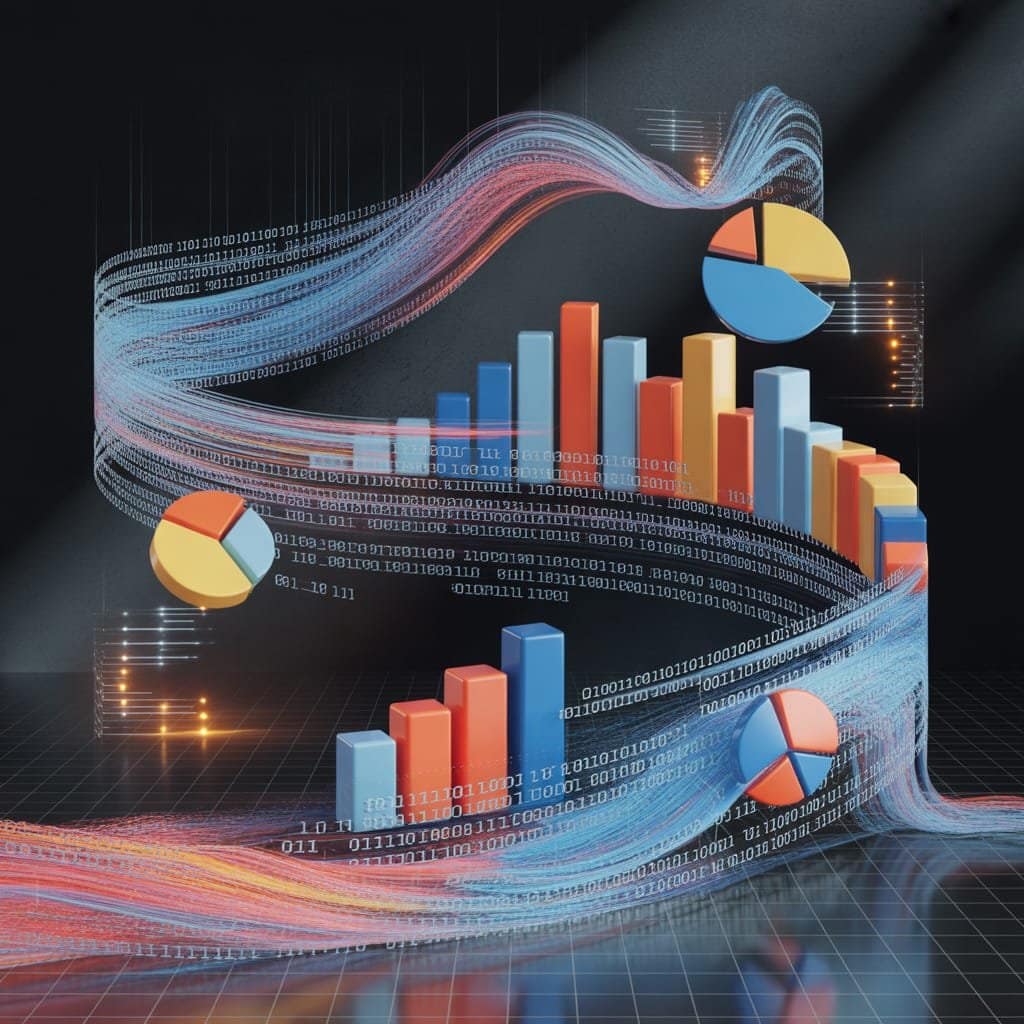Ever feel completely swamped by numbers, endless spreadsheets, or just plain guessing when you’re making important business decisions? Maybe you’re staring at your Etsy sales, poring over blog stats, or trying to figure out which AI-generated design will really grab your buyers’ attention. It’s a common struggle, isn’t it? We all dream of building something amazing and unique, but it’s so easy to get lost in a sea of information.
Sure, information is incredibly powerful – but only if you can actually make sense of it. Raw data, with all its intimidating rows and columns, can feel totally overwhelming. It’s like having every single ingredient for a magnificent cake but absolutely no recipe. You know it could be delicious, but you have no idea how to put it all together.
That’s exactly where data visualization comes in. It’s not just about pretty charts (though they definitely can be eye-catching!). It’s about turning complicated data into clear answers. Think of it as giving your data a voice, a compelling story to tell. This helps you make smarter, quicker, and much more confident decisions. It’s not just a fancy trick for big corporations; it’s a vital skill for any business owner today, especially in our visually driven world. With the right data visualization tools, you’ll see things with incredible clarity.
Why Truly Seeing Your Data Is Your Secret Power
For creative business owners, Etsy sellers, print-on-demand pros, and content creators, truly seeing your data isn’t just a nice-to-have; it’s absolutely essential.
Just picture this:
As a Creative Business Owner: You’re constantly brainstorming new product ideas. AI helps you whip up amazing concepts, but which ones will actually sell? Instead of just guessing, imagine instantly seeing which colors are flying off the shelves, what themes are trending, or exactly how your pricing impacts sales. Visualizing your data lets you track customer behavior, spot market gaps, and fine-tune your product strategy without playing a guessing game. You’d know in a flash if that vintage-style t-shirt is outselling the minimalist mug, or if your latest ad campaign is really hitting the mark. No more just throwing things at the wall to see what sticks!
As a Content Creator or Marketer: You’re a storyteller, and visuals are your primary language. But are your stories really resonating? Are people actually reading your blog posts? Is your social media content grabbing attention? Generic stock photos just don’t cut it anymore. By visualizing details about your audience, your content’s performance, or your social reach, you can create content that genuinely connects. You’ll quickly discover which topics drive the most traffic, when your audience is most active, or which platforms deliver the best return on investment (ROI). This isn’t just about making your content look good; it’s about making it perform better. It helps you build strong strategies based on solid insights.
Simply put, visualizing your data helps you cut through the noise, understand why things are happening, and uncover the exact insights you need to grow your business smartly. It’s all about using visual data analysis to transform raw numbers into a clear, actionable plan for your next big move.
Before We Start: What Question Do You Need to Answer?

Before you even think about picking a chart, hit pause and really reflect. The biggest mistake people make is grabbing a pretty chart without first asking themselves: “What specific question am I trying to answer with this data?”
Seriously, think it through. Are you trying to:
Compare a couple of things?
Track how something has changed over time?
Break down the components of a whole?
Uncover connections between different elements?
Visualize patterns on a geographical map?
Your question acts like a compass, guiding you directly to the perfect chart. Without it, you’re just doodling, not telling a compelling story. This initial step is super important – it’s the very foundation of our “Chart Chooser’s Guide.”
The Chart Chooser’s Guide: How to Pick the Best Data Chart for Any Business Question
Alright, let’s get practical. This guide is your go-to for turning your data into a clear story, no matter the challenge.
Step 1: What’s Your Core Question?
Let’s be real with ourselves here. What exact insight do you really need to uncover? What decision are you genuinely trying to make?
Are you comparing things? (e.g., “Which of my five new sticker designs sold best last month?” or “How do my Instagram likes stack up against my Facebook likes?”)
Are you showing how things are spread out? (e.g., “What’s the typical price range for my competitors’ products?” or “How many customers fall into each age group?”)
Are you trying to find a connection? (e.g., “Does spending more on ads actually lead to more sales?” or “Is there a link between how many product photos I use and conversion rates?”)
Are you tracking changes over time? (e.g., “How have my monthly Etsy sales shifted over the past year?” or “Has my blog traffic increased since I started posting twice a week?”)
Are you showing parts of a whole? (e.g., “What percentage of my website visitors come from social media, search engines, or directly?” or “What are the biggest cost components for my print-on-demand products?”)
Are you visualizing locations on a map? (e.g., “Where are the majority of my customers located?” or “Which geographical regions generate the most revenue?”)
Pinpoint your main question. It’ll be your North Star when building your chart.
Step 2: What Type of Data Are You Working With?
Once you’ve nailed down your question, take a peek at your actual data. What kind of information is it? Don’t worry, it’s not as intimidating as it sounds!
Number Data: These are things you can count or measure (think sales figures, website visits, profit margins, or customer ages).
Group Data: These are names or labels that categorize things (like different product types, traffic sources, customer genders, or advertising channels).
Understanding these basic data types will help you choose charts that genuinely represent your information.
Step 3: Match Your Goal and Data to the Right Chart Type
Alright, time to play matchmaker! Here are some common goals and the charts that will serve them best:
Goal: Comparison
Go-To Charts: Bar Charts (perfect for comparing different categories), Column Charts (just like bar charts, but standing tall, great for comparing groups or short timeframes), Grouped Bar/Column Charts** (when you need to compare smaller subgroups within larger ones), Bullet Charts (excellent for gauging performance against a specific goal).
Creative Biz Owner Example: A bar chart comparing the profit margins of your various products (think t-shirts vs. mugs vs. tote bags).
Content Creator Example: A column chart displaying the unique visitor count for your top 5 blog posts last month.
Goal: Distribution (How things are spread out)
Go-To Charts: Histograms (show how frequently values appear within different ranges, like customer ages), Box Plots (illustrate the range and median of data, helpful for comparing data spread across groups), Scatter Plots (if you’re looking at the distribution of two numerical variables together).
Creative Biz Owner Example: A histogram revealing the typical price range your competitors charge for similar products.
Content Creator Example: A box plot comparing how long visitors from different social media platforms tend to stay on your page.
Goal: Relationship (How things connect)
Go-To Charts: Scatter Plots (your absolute best friend for showing how two numerical variables relate), Bubble Charts (like scatter plots, but they add a third numerical dimension represented by the size of the bubble).
Creative Biz Owner Example: A scatter plot to see if more product reviews correlate with a higher average rating.
Content Creator Example: A scatter plot to determine if increased social media engagement leads to more website visitors.
Goal: Composition (Parts of a Whole)
Go-To Charts: Stacked Bar/Column Charts (fantastic for showing how different components contribute to a total, especially over time or across groups), Treemaps (ideal for hierarchical data, showing groups within groups and their relative sizes), Pie Charts (use with caution! Best for a very limited number of parts that add up to 100%, and only when the differences are strikingly obvious).
Creative Biz Owner Example: A stacked column chart illustrating how your quarterly sales are broken down by product type.
Content Creator Example: A pie chart (if you have just 2-4 segments) or a stacked bar chart showing the percentage of your audience coming from various sources (search engines, social media, paid ads).
Goal: Change Over Time
Go-To Charts: Line Charts (the undisputed champion for tracking how things change over a continuous period), Area Charts (similar to line charts, but the space below the line is filled in, great for showing total quantity or volume over time).
Creative Biz Owner Example: A line chart charting your monthly income over the past two years.
Content Creator Example: An area chart depicting the growth of your email subscriber list over time.
Goal: Geographical (Map Data)
Go-To Charts: Shaded Maps (where regions are colored based on a numerical value, like population density or sales per state), Symbol Maps (where symbols are placed on a map, with their size or color indicating a numerical value, such as sales at different store locations).
Creative Biz Owner Examples A shaded map highlighting which states your Etsy customers primarily reside in.
Content Creator Example: A symbol map showing clusters of your blog’s most active readers.
Step 4: Keep It Clean and Understandable
You’ve chosen your chart – fantastic! Now, let’s make sure it’s not just informative but also beautifully clear and easy to grasp.
Ditch the “Chart Junk”: Get rid of any unnecessary lines, shadows, or an overwhelming rainbow of colors that only distract from the core message. Simpler nearly always wins.
Crystal-Clear Titles & Labels: Your chart’s title should immediately tell viewers what they’re looking at. And please, label those axes clearly so no one’s left guessing!
Purposeful Color Use: Use color strategically to emphasize key points, not just to decorate. For instance, a standout color can highlight the specific data you want people to notice.
Consider Your Audience: Will the folks who see this (your team, customers, or even you in a month) quickly understand the main takeaway? If there’s any doubt, simplify, simplify, simplify!
Step 5: Experiment and Get Feedback
Don’t be shy about trying a few different chart types for the same data. Does one tell the story more powerfully? Does another reveal an insight you hadn’t considered? Even better, ask a friend or colleague to take a quick look – can they instantly grasp the main point? This process of trying things out and refining is really important for effective visual data analysis. It ensures your charts don’t just present information, but truly help you make solid decisions.
Key Chart Tools: Your Digital Art Kit
Now that you’re good at picking charts, let’s talk about the data visualization tools that can make your ideas real. You don’t need a lot of money or a special degree to use these; many are easy to get and simple to use.
For Quick & Easy (and Often Free!) Options
Google Sheets / Microsoft Excel: Seriously, don’t overlook these workhorses! Most of us already have them, and both let you create robust charts directly within your spreadsheets. They’re fantastic for straightforward comparisons, tracking changes over time, or breaking down a whole. You can whip up bar charts, line charts, pie charts, and more, then easily export them for presentations or reports. If you’re new to charting, these are the perfect starting point.
Canva: Chances are, you’re already using Canva for your designs, right? Well, it’s not just for crafting stunning social media graphics or product mockups anymore! Canva has integrated chart tools. You can quickly plug in your data and generate beautiful, branded charts. This is a huge win for content creators and creative business owners who want to embed charts directly into their blog posts, presentations, or marketing materials without ever leaving the platform. It’s for those who appreciate good design and good data!
Google Data Studio (now Looker Studio): This free Google tool is super powerful for building interactive dashboards and reports. If your data lives in Google Analytics, Google Sheets, or other Google products, Looker Studio connects seamlessly. It’s ideal for creating dynamic, live reports you can share or use to monitor your key metrics all in one central place. Think of it as your own free, customized business control panel.
For More Detail & Interaction (Still User-Friendly)
Tableau Public: Tableau is widely considered a gold standard for data visualization, and their free “Public” version is an absolute gem. You can create highly interactive and sophisticated charts, publish them online, and explore your data in fascinating new ways. It has a slightly steeper learning curve than Sheets or Canva, but if you’re serious about diving deep into making decisions with charts and tackling more complex datasets, Tableau Public is an incredibly valuable platform for both learning and sharing.
Flourish Studio: Ever wanted to create dynamic, engaging, and interactive charts that truly captivate your audience? Flourish Studio makes it surprisingly simple. Just upload your data and choose from a vast library of stunning templates, including animated bar chart races or interactive maps. It’s perfect for content creators who want to tell more compelling stories with moving visuals, rather than just static images.
How AI is Revolutionizing Charts
As artificial intelligence continues to evolve, we’re seeing some seriously cool advancements in how it can automate chart creation. Soon, or already in some tools, AI can:
Generate Charts from Simple Questions: Imagine typing something like, “Show me my monthly sales for the last year, broken down by product type,” and the AI instantly suggests and builds the perfect chart for you.
Recommend the Best Chart Type: Based on your specific data and the question you’re asking, AI can intelligently recommend the most effective chart type, saving you time and ensuring maximum clarity.
Keep an eye out for these emerging features! They’re set to make data visualization tools even more accessible and powerful for everyone, especially for those of us already leveraging AI to create products and content.
Putting It All Together: Your Data Superpower

Diving into data visualization might feel a little daunting at first. But here’s the secret: with a clear game plan (our Chart Chooser’s Guide!) and the right data visualization tools at your fingertips, you’re not just staring at numbers anymore. You’re giving your intuition solid, undeniable facts to back it up.
For the creative business owner, this translates into confident decisions about your next product launch, a deeper understanding of your customers, and smarter allocation of your marketing budget. For the content creator, it means crafting stories that truly resonate, connecting with your audience on a profound level, and ensuring your hard work delivers tangible results.
So, seriously, stop guessing! Start seeing things clearly. Begin experimenting with these tools and this guide, and prepare to witness how your newfound skill in making decisions with charts truly changes the way you run your business.
You’ve got this. Now, go tell your data’s amazing story!


